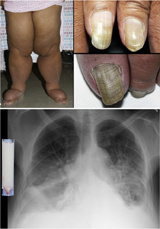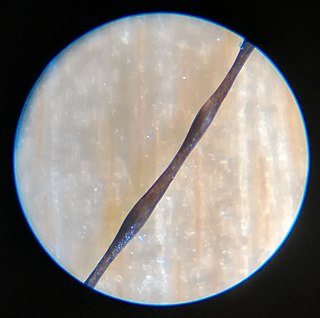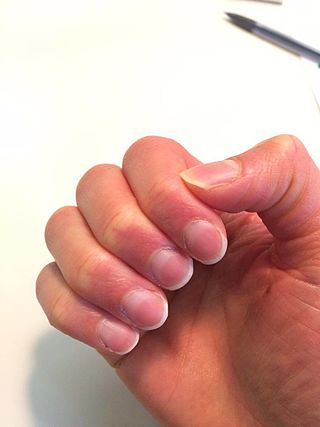Related Research Articles

A nail disease or onychosis is a disease or deformity of the nail. Although the nail is a structure produced by the skin and is a skin appendage, nail diseases have a distinct classification as they have their own signs and symptoms which may relate to other medical conditions. Some nail conditions that show signs of infection or inflammation may require medical assistance.

Nail clubbing, also known as digital clubbing or clubbing, is a deformity of the finger or toe nails associated with a number of diseases, mostly of the heart and lungs. When it occurs together with joint effusions, joint pains, and abnormal skin and bone growth it is known as hypertrophic osteoarthropathy.

Ectodermal dysplasia (ED) is a group of genetic syndromes all deriving from abnormalities of the ectodermal structures. More than 150 different syndromes have been identified.

Beau's lines are deep grooved lines that run from side to side on the fingernail or the toenail. They may look like indentations or ridges in the nail plate.

Onycholysis is a common medical condition characterized by the painless detachment of the nail from the nail bed, usually starting at the tip and/or sides. On the hands, it occurs particularly on the ring finger but can occur on any of the fingernails. It may also happen to toenails.

Yellow nail syndrome, also known as "primary lymphedema associated with yellow nails and pleural effusion", is a very rare medical syndrome that includes pleural effusions, lymphedema and yellow dystrophic nails. Approximately 40% will also have bronchiectasis. It is also associated with chronic sinusitis and persistent coughing. It usually affects adults.

Koilonychia, also known as spoon nails, is a nail disease that can be a sign of hypochromic anemia, especially iron-deficiency anemia. It refers to abnormally thin nails which have lost their convexity, becoming flat or even concave in shape. In a sense, koilonychia is the opposite of nail clubbing. In early stages nails may be brittle and chip or break easily.

Hay–Wells syndrome is one of at least 150 known types of ectodermal dysplasia. These disorders affect tissues that arise from the ectodermal germ layer, such as skin, hair, and nails.

Monilethrix is a rare autosomal dominant hair disease that results in short, fragile, broken hair that appears beaded. It comes from the Latin word for necklace (monile) and the Greek word for hair (thrix). Hair becomes brittle, and breaks off at the thinner parts between the beads. It appears as a thinning or baldness of hair and was first described in 1897 by Walter Smith

Terry's nails is a physical condition in which a person's fingernails or toenails appear white with a characteristic "ground glass" appearance without any lunula. The condition is thought to be due to a decrease in vascularity and an increase in connective tissue within the nail bed; the darker shade of the distal portion of the nail fades upon pressure, which differentiates Terry's nails from Lindsay's nails. It frequently occurs in the setting of liver failure, cirrhosis, diabetes mellitus, congestive heart failure, hyperthyroidism, or malnutrition. Eighty percent of patients with severe liver disease have Terry's nails, but they are also found in people with kidney failure, in patients with congestive heart failure and are described as a brown arc near the ends of the nails. The recognition of characteristic nail patterns, such as Terry's nails, may be a helpful herald for early diagnosis of systemic diseases. This finding was named for Richard Terry.

Trachyonychia is a condition characterized by rough accentuated linear ridges on the nails of the fingers and toes. When the condition occurs on all the twenty nails of the fingers and toes, it is known as twenty-nail dystrophy, most evident in childhood, favoring males.

Muehrcke's nails or Muehrcke's lines are changes in the fingernail that may be a sign of an underlying medical condition. The term refers to a set of one or more pale transverse bands extending all the way across the nail, parallel to the lunula. In contrast to Beau's lines, they are not grooved, and in contrast to Mees' lines, the thumb is usually not involved.

Hair diseases are illnesses that impact the persistence and regular growth of hair. Types of hair diseases include folliculitis, hirsutism, hypertrichosis, hypotrichosis (alopecia), Menkes kinky hair syndrome, monilethrix, and piedra.

Onychomadesis is a periodic idiopathic shedding of the nails beginning at the proximal end, possibly caused by the temporary arrest of the function of the nail matrix. One cause in children is hand, foot, and mouth disease. This generally resolves without complication.

Half and half nails show the proximal portion of the nail white and the distal half red, pink, or brown, with a sharp line of demarcation between the two halves. The darker distal discoloration does not fade on pressure, which differentiates Lindsay's nails from Terry's nails. The discoloration is thought to be due to β-melanocyte–stimulating hormone. Seventy percent of hemodialysis patients and 56% of renal transplant patients have at least one type of nail abnormality. Absence of lunula, splinter hemorrhage, and half and half nails were significantly more common in hemodialysis patients, while leukonychia was significantly more common in transplant patients.
Congenital onychodysplasia of the index fingers is defined by the presence of the condition at birth, either unilateral or bilateral index finger involvement, variable distortion of the nail or lunula, and polyonychia, micronychia, anonychia, hemi-onychogryphosis, or malalignment.
Shell nail syndrome is a medical condition defined by the concurrence of large, rounded fingernails and bronchiectasis. Despite the visual similarity between the two conditions, shell nail syndrome and clubbed fingernails are opposites. Shell nail syndrome results from atrophy to the nail bed, whereas clubbed fingernails results from a bulbous, hypertrophic growth of soft tissue. The concurrence of the syndrome and bronchiectasis is well-established, however the exact causes of the deformity remains unknown. The syndrome has been observed affecting both the hands and larger toenails.
Pterygium inversum unguis or ventral pterygium is characterized by the adherence of the distal portion of the nailbed to the ventral surface of the nail plate. The condition may be present at birth or acquired, and may cause pain with manipulation of small objects, typing, and close manicuring of the nail. secondary due to connective tissue disorders. Pterygium inversum unguis is often asymptomatic.

In racquet nails, the nail plate is flattened, the end of the thumb is widened and flattened, and the distal phalanx is abnormally short. In racquet nails, the width of the nail bed and nail plate is greater than their length. The condition is painless and asymptomatic.
Parakeratosis pustulosa is a cutaneous condition which is exclusively seen in children, usually involving one finger, most commonly the thumb or index finger, with the affected nail showing subungual hyperkeratosis and onycholysis.
References
- ↑ James, William; Berger, Timothy; Elston, Dirk (2005). Andrews' Diseases of the Skin: Clinical Dermatology, p. 786. (10th ed.). Saunders. ISBN 0-7216-2921-0.